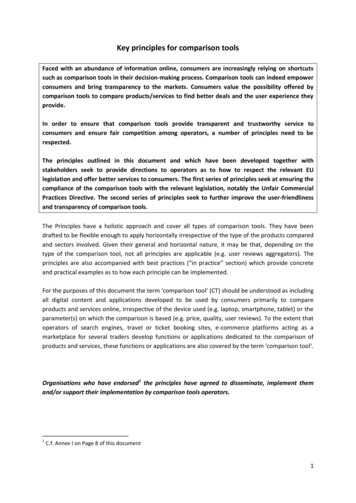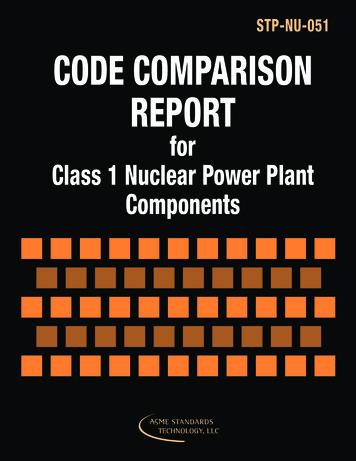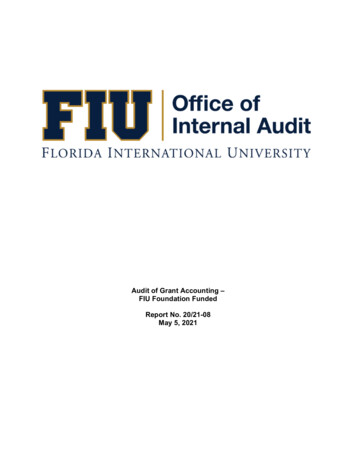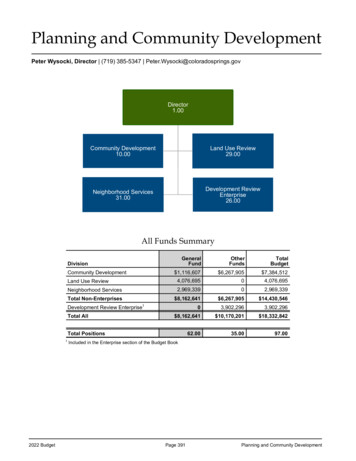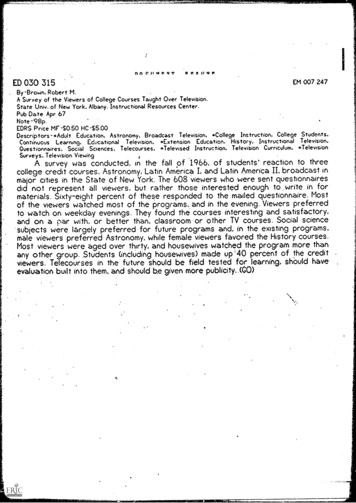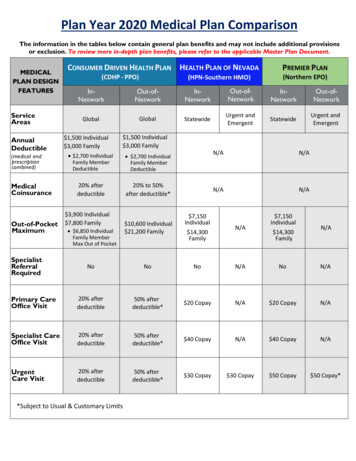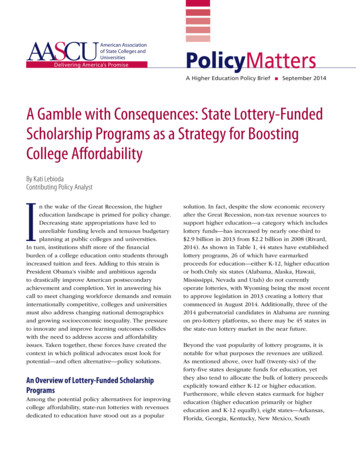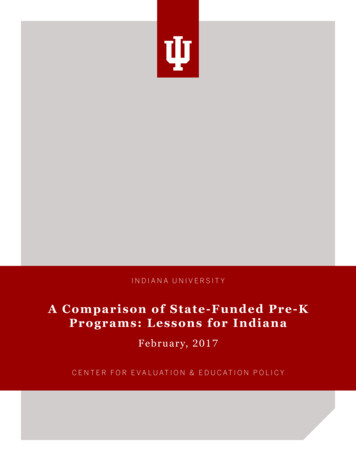
Transcription
INDIANA UNIVERSITYA Comparison of State-Funded Pre- KPrograms: Lessons for IndianaF eb ru ary, 2017C E N T E R F O R E VA L U AT I O N & E D U C AT I O N P O L I C Y
ABOUT THE AUTHORSColleen Chesnut, Ph.D., (cechesnu@indiana.edu) is a Research Associateat the Center for Evaluationand Education Policy (CEEP).Her research focuses on policyimplementation for stakeholdersacross the P-16 spectrum,educational leadership, issues ofequity for English lanugage learners,and school law.Gina Mosier is a Ph.D. candidatein Inquiry Methodology at IndianaUniversity Bloomington. She was aGraduate Research Assistant for theCenter for Evaluation and EducationPolicy. She is currently an impactmethods and analysis specialist withThomas P. Miller & Associates.Thomas Sugimoto (tjsugimo@indiana.edu) is an EvaluationCoordinator with CEEP. Hereceived his Master in PublicAffairs degree from the School ofPublic and Environmental Affairs(SPEA) at Indiana University. Hehas experience in K-12 programevaluation and finance analysis,including randomized controlledtrial studies, formative evaluations,and data visualization.Anne-Maree Ruddy, Ph.D. (aruddy@indiana.edu) is the Director forEducation Policy and a SeniorResearch Associate at the Centerfor Evaluation and EducationPolicy. Her research focuses onanalysis of policy, its development,and implementation in educationsystems emphasizing schoolenvironments and higher education.Dr. Ruddy coordinates CEEP’spolicy-related activities to promotehigh-quality information aboutP–20 education used by the generalpublic, education community andpolicymakers.For questions about this researchor accompanied data visualization,please contact Colleen Chesnut atcechesnu@indiana.edu.AC K N OW L E D G E M E N TSThe authors would like to thankthree CEEP staff members fortheir assistance with this report:Rebekah Sinders, for formattingand designing the tables, LeeAnnSell, for assisting with early phasesof research, and Lisa SimmonsThatcher, for assisting with finaledits.Table of ContentsExecutive Summary4LITERATURE REVIEW5Highlights and trends across states10Table 1. Eligibility Requirements for State-funded pre-KPrograms, 2014-201512Table 2. Quality Standards and Measures of ProgramEffectiveness for State-funded pre-K Programs, 2014-201513State 20Nebraska22Ohio24South 4Recommendations35References37References by State41Appendix: Glossary of Acronyms and Terms49
EXECUTIV E SU M M A RYIn order to inform the Indiana State Board of Education’s decision-making on Indiana’s On My Way Pre-K Pilot program,researchers at the Center for Evaluation and Education Policy (CEEP) at Indiana University compiled existing data on ten statesthat have implemented pilot pre-Kindergarten (pre-K) programs and subsequently expanded these programs beyond the pilotphase. This technical report presents the results of this inquiry, including a review of research on pre-K programs, highlights andtrends across the states, individual state profiles, and recommendations for Indiana.States and Program Characteristics ExaminedThe ten states selected for this research were: Georgia, Illinois, Massachusetts, Michigan, Nebraska, Ohio, South Carolina,Tennessee, Virginia, and Wisconsin. These states were selected because they have piloted state-funded pre-K programs andsubsequently expanded their programs beyond the pilot phase. Publicly-available data were examined on characteristics ofstate-funded pre-K programs. These characteristics were selected in order to provide comprehensive snapshots of state-fundedpre-K programs in each state. The characteristics include: History of program development and expansion Funding source(s) and amounts Quality standards for service providers Eligibility requirements for students/families Enrollment numbers Number and types of service providers Measures of program effectivenessKey Findings and RecommendationsThe states with the highest amounts of total funding allocated to pre-K serve the most students. Most of the ten states providefunding for pre-K via general revenue funds, but a few use lottery funding. For example, Georgia funded pre-K with 312 millionin lottery funds, enrolled 80,430 students, and served 100% of school districts during 2014-2015. By contrast, the three stateswith the lowest levels of total funding (Nebraska, Ohio, and South Carolina) also enrolled the fewest children. An increase in totalfunding and consideration of funding sources in addition to the state’s general revenue fund are recommended for expandingaccess to pre-K in Indiana. This may include funding options available through federal grants; several of the states examined inthis report have recently received federal funding to enhance quality of and access to their state-funded pre-K programs.All states have a minimum age requirement for children to be eligible for pre-K, generally three or four years old. Most states alsoutilize family income level as an eligibility factor, and some employ additional criteria to target at-risk children. Indiana is the onlystate that limits access to state-funded pre-K to children in just a few counties. Expanding eligibility beyond these five counties isrecommended for Indiana’s pre-K programs.States vary in terms of meeting or exceeding program quality benchmarks established by NIEER and outlined in research oneffective pre-K programs (e.g., Barnett et al., 2016; Weschler et al., 2016), including accreditation, teacher quality, staff to childratios, curricula, and quality monitoring. Those meeting benchmarks generally have more clearly-established accreditationguidelines, well-prepared teachers, lower staff to child ratios, and research-based curricula, assessments, and quality monitoringprocesses. Furthermore, several states have dedicated funds and efforts towards regular external evaluation of their pre-Kprograms. While increasing access to Indiana’s pre-K programs is important, it will also be crucial to focus on enhancing thequality of these programs, via attention to best practices exemplified in other states and research on early education.For a detailed overview of the state programs including funding, enrollment, eligibility requirements, and quality measurementsplease refer to CEEP’s interactive data visualization.4Indiana University Center for Evaluation & Education Policy
LITE RATU R E R EV I EWHistory of the pre-Kindergarten MovementThe pre-Kindergarten (pre-K) movement has its roots in the 1960s, with the creation of the Head Start program in 1965, whichensured half-day preschool for children from low-income families. Today, the federal Head Start/Early Head Start programoffers not only preschool, but nutrition, health, and other services for infants and children who are at-risk. However, theprogram serves less than half of the eligible children from low-income families (Schmit, Matthews, Smith, & Robbins, 2013).To fill this void, local, city, and county providers have created programs across the country (Muenchow & Weinberg, 2016) andstate-funded programs have increased in number.Enrollment in pre-K EducationFrom 2000 onward, the nation has seen growth in state-funded pre-K programs, despite a downturn in the economy and theeconomic challenges of funding for early education programs. In the 2001–2002 school year, 581,705 four-year-olds, or 14.8percent of the entire population in this age group, were enrolled in 45 state-funded pre-K programs in 40 states (Barnett et.al., 2003). By 2009-2010, the number increased to 1,292,310. Throughout this period the number of programs increased aswell, with 52 different state-funded programs in 40 states and the District of Columbia (Barnett et al., 2010.). Despite thiscontinuing upward trend, in 2013 only half of all three- and four-year-olds in the United States (U.S.) were enrolled inpreschool programs (both public and private). Of these children, the majority were from high-income families rather thanmiddle-and low-income families (National Women’s Law Center, 2013). Yet, research has shown that children from lowincome families are the ones that benefit the most from pre-K education (Garcia, Heckman, Leaf, & Prados, 2016).Benefits of pre-K EducationResearch shows that investing in pre-K education provides a myriad of benefits, both in the short-term as well as long-term.Not only did children in their early years in pre-K education programs perform better than children not enrolled in pre-Keducation, but they also had better learning outcomes later in their education and were more likely to graduate high schooland retain their jobs than students who did not attend pre-K education. Furthermore, students who were enrolled in pre-Keducation had higher salaries and had fewer arrests than those who were not in pre-K education (Schweinhart, Montie,Xiang, Barnett, Belfield, & Nores, 2005). The families of these students also benefitted if the program offered childcare aswell (Barnett & Masse, 2007). Lastly, students enrolled in pre-K programs had better health than those who were notenrolled (Campbell et al., 2014). According to O’Brien and Devarics (2007), pre-K programs are the “gift that keeps on giving”because children in programs experienced a multitude of educational, economic, and health benefits. Lynch (2007) foundthat investing in pre-K programs helped create billions of dollars in benefits for state and federal governments.Not only does the child who attends pre-K benefit, but so does society. When students were enrolled in pre-K educationprograms, less taxpayer money was spent on special education, criminal justice, unemployment benefits, and public benefits(Karoly & Bigelow, 2005). Furthermore, since participants in the pre-K programs had higher incomes than those who werenot in pre-K programs, these participants contributed more taxes on their earnings. A cost-benefit analysis of pre-K spendingfound a 12.90 return on each dollar spent on pre-K education. For a cost of 15,166 of pre-K education, the total publicbenefit was 195,621 per student (Schweinhart et al., 2005).Two seminal studies cited frequently on pre-K education: (a) the HighScope Perry Preschool Study, and (b) the AbecedarianEarly Childhood Intervention Project detail the aforementioned advantages. These studies utilized randomized control trialsthat examined longitudinal outcomes of students who were enrolled in pre-K programs compared to students who werenot enrolled. The results from these studies contribute to our knowledge of the benefits of pre-K programs, as the studieswere some of the few randomized control trials that examined longitudinal outcomes of students who were enrolled in pre-Kprograms compared to students who were not enrolled (Barnett & Masse, 2007). In addition to these two studies,researchers examining early childhood education have found similar benefits of pre-K programs.5
LITE RATU R E R EV I EWThe HighScope Perry Preschool study investigated the impact of pre-K education on children from low-income families thatwere considered at-risk for failing in school. Children aged three and four were randomly separated into two groups. Onegroup received a pre-K program that followed HighScope’s instructional approach, while another group received no pre-Kprogram (Schweinhart et al., 2005). Researchers followed students in both groups from the start of the program through laterin life, and the most recent follow-up was performed when these participants were 40 years old. Researchers also collecteddata from the participants’ schools, as well as social services and arrest information. They found that students in the pre-Kprograms experienced better learning outcomes, earned more income, and had fewer arrests (Schweinhart et al., 2005).The North Carolina Abecedarian Early Childhood Intervention project was similar to the HighScope Perry Preschool studyin that it was a randomized control study examining the benefits of pre-K education for children from minority low-incomefamilies. Four cohorts of infants were randomly assigned to one of two groups. One group received early education programs,and the other group did not. Whereas the HighScope project only included half-day preschool, the Abecedarian projectincluded half-day preschool as well as full-day childcare.1 Additionally, children attended this program from infancy tokindergarten (Ramey et al., 1974). Akin to the HighScope study, researchers in the Abecedarian study found that children whoreceived early education programs experienced better outcomes. Several follow-up studies have been performed with studyparticipants. A recent follow-up study with participants aged 30 years old found that individuals in the program experiencedbetter social-emotional, educational, and economic outcomes than those who did not receive early childhood educationprograms (Campbell et al., 2012). Past studies have also found increased academic and cognitive scores as well as increasedlikelihood of college attendance among other benefits (Campbell, Ramey, Pungello, Sparling, & Miller-Johnson, 2002; Clarke& Campbell, 1998). Furthermore, results from a benefit-cost analysis showed that mothers of children in the program earnedgreater income than the mothers of children in the control group. Additionally, children who received the early educationprogram earned more income (Barnett & Masse, 2007).The Chicago Longitudinal Study examined the effects of an early education initiative on low-income students. This earlyeducational program operated in 20 different schools and provided assistance for children from low-income families beginningat age three up to the age of nine. In the study, the outcomes of children who participated in the program were examined,as well as outcomes from a comparison group. The most recent study followed up with participants at age 26. Similar to theHighScope project, researchers performed a cost-benefit analysis and found an 18 percent return on investment annually forthe program. Additionally, for every one dollar that was invested in the early childhood program, there was approximately an 11 return to the community over the child’s lifetime. These returns were found through increased income for participants, taxrevenues, and decreased costs from the criminal justice system (Reynolds, Temple, White, Ou, & Robertson, 2011).Another recent study which evaluated the outcomes of two influential early childhood programs in North Carolina throughrandomized control trails showed positive longitudinal results. The program targeted children from low-income families,and the study followed the participants into their mid-thirties. The researchers found a plethora of other benefits, including:increased salaries for participants and their mothers, improvements in health, quality of life and education, and a decrease incrime. Additionally, researchers estimated that the benefit-cost ratio of 6.3 and a rate of return of 13% annually, after adjustingfor welfare costs of funding the program through taxes, providing a benefit for taxpayers and the community at large (Garcia etal., 2016).Other studies estimate the return on investment for non-targeted universal pre-K programs is between two and four dollarsfor every dollar invested (O’Brien & Devarics, 2007). As not all pre-K programs are created equal, high-quality programs garnerthe most gains (Lynch, 2007). Successful programs such as HighScope and Abecedarian had small staff-to-student ratios andsmall class sizes, which have been shown to be most beneficial for student learning (Ackerman & Barnett, 2006). Researchershave found that some of the core elements of success for high-quality pre-K programs include: learning goals connectedSome research has shown that low-income students enrolled in full-day pre-K programs have more significantly improved learning outcomesthan those in half-day programs (Robin, Frede, & Barnett, 2006).16Indiana University Center for Evaluation & Education Policy
LITE RATU R E R EV I EWto K-12 standards, low student/staff ratios, small class sizes, and highly-trained teachers with proficiency in early childhoodeducation (Gayl, 2008).There is some critique on whether pre-K programs such as HighScope and Abecedarian can be replicated with fidelity acrossthe U.S. Moreover, would the same results be found for all children? Though researchers did find positive results for thesetwo randomized control studies for these particular disadvantaged children, it is uncertain if these results are generalizableto other groups of children (Barnett, 2011). Equally, there is some critique of the long term outcomes of some of the pre-Kprograms (Lipsey, Farran, & Hofer, 2015; Puma, Bell, Cook, & Heid, 2010; Puma et al., 2012). These studies have suggested thatthe positive effects of pre-K may fade over time. Further studies indicate that variables, and thus findings, differ considerablyacross pre-K research studies related to the following program elements: Program quality and implementation, Program financial resources, Program duration, Program populations served, and Elementary school quality and continuing attention from teachers (Workman, Palaich, & Wool, 2016, p. 11).Enrollment numbers for the nation are provided earlier in this review of the literature. Further, four of the variables specificallyaddressed in our study, quality, funding, duration, and eligibility requirements are briefly discussed, below.Quality. Research not only illustrates the benefits of pre-K education but also illustrates the importance of high-quality earlychildhood programs (Yoshikawa et al., 2013). Many states have established quality standards, requirements or guidelines forpre-K service providers, and these vary across the states. Work conducted by Wechsler, Melnick, Maier, and Bishop (2016)summarizes the comprehensive research on programs, “demonstrating positive results, as well as the professional standardsfor early education, identifying important elements of quality,” (p. 1). According to Weschler et al. (2016, p.1), these elements ofquality include but are not limited to: Early learning standards and curricula that address the whole child, are developmentally appropriate, and areeffectively implemented. Assessments that consider children’s academic, social-emotional, and physical progress and contribute toinstructional and program planning. Well-prepared teachers who provide engaging interactions and classroom environments that support learning. Ongoing support for teachers, including coaching and mentoring. Support for English learners and students with special needs. Meaningful family engagement. Sufficient learning time. Small class sizes with low student-to-teacher ratios. Program assessments that measure structural quality and classroom interactions. A well-implemented state quality rating and improvement system.The National Institute for Early Education Research (NIEER), which compiles data annually on state-funded pre-K programsin the U.S., uses similar metrics to assess program quality. Since 2003, annual NIEER yearbooks on pre-K programs indicatedwhich state programs meet certain benchmarks related to program quality in the following areas: early learning standards,teacher and assistant teacher degrees or certifications and training, teacher in-service, class sizes, staff to child ratios,additional screening and support services, meals, and quality monitoring (Barnett et al., 2016). As some research on pre-Koutcomes demonstrates, even state-funded programs that meet quality benchmarks may not benefit all students in the longterm. For example, in response to findings that positive effects of pre-K participation diminished by the time students werein third grade, policymakers in Tennessee increased their focus on enhancing quality standards, even though state-fundedprograms already met most of the benchmarks outlined by NIEER (Lipsey et al., 2015).7
LITE RATU R E R EV I EWFunding. In the 2015-2016 fiscal year, state funding for pre-K in all states increased by 755 million to a total of nearly 7 billion. The Education Commission of the States noted that “this is a 12 percent increase in state investment in pre-Kprograms, which builds on an additional 12 percent increase during the 2014–2015 fiscal year,” (Parker, Atchison, & Workman,2016, p. 2). The authors also noted that in 2015-2016, only five states (Idaho, Montana, New Hampshire, South Dakota, andWyoming) did not provide state funding for pre-K in some form. This compares to 11 states that were not investing in pre-Kthree years prior. While funding levels for pre-K programs increased in 32 states in 2015-2016, as noted previously, less thanhalf of preschool aged students nationally have access to pre-K programs.In terms of federal funding, starting in 2012, the U.S. Department of Education began offering competitive awards for earlylearning programs, and several of the states examined in this report applied for and received these grant monies. In 2016,the Every Student Succeeds Act (ESSA) created an opportunity to increase funding for early childhood education via Title Iand Title II funding as well as Preschool Development Grants. In January 2017, the Office of Head Start announced that it willdisburse 290 million to 665 Head Start and Early Head Start programs around the country that may be used to expand to fullschool day and year offerings (Samuels, 2017). Congress appropriated the supplemental funding in a fiscal 2016 budget bill(P.L. 114-113).Duration. Research indicates that pre-K program duration, including number of days per year and number of hours per day,may impact the programs’ effects on children and families. For example, a study examining cognitive gains in reading and mathfor children attending preschool centers found that the most significant gains occurred for low-income children who attendedat least 30 hours per week and nine months or more per year (Loeb, Bridges, Bassok, Fuller, & Rumberger, 2007). A studyexamining the effects of an early literacy intervention implemented in preschool classrooms also found that the interventionhad the greatest positive impacts for children who attended full-day, rather than half-day programs (Landry, Swank, Smith,Assel, & Gunnewig, 2006). Cost-benefit analysis has also shown that returns on investment for full-day pre-K programs arehigher than those for half-day programs, particularly for low-income and working parents (Barnett & Masse, 2007).Recent data from national research on state-funded pre-K programs reveals that among state programs, there is roughlyan even split between those offering full-day (between four and eight hours) and half-day (fewer than four hours) programs.In most state pre-K programs, services are offered during the academic year. Additionally, 11 states allow for localities todetermine the number of hours per day for their programs, and 19 states allow for local determination of programs’ operatingschedules (Barnett et al., 2016).Eligibility. Eligibility requirements vary across states. Generally, states offer services for children who are at least four yearsold (who are not yet kindergarten-eligible), with some extending services to three-year-olds.The National Institute for Early Education Research (NIEER) 2013 State of Preschool Yearbook reported on the eligibilitypolicies of 53 state-funded pre-K programs, offered in 40 states and the District of Columbia (Barnett et al., 2013). Carolanand Connors-Tadros (2015, p.5) noted that, “of the 53 programs profiled, 17 (32%) have no eligibility requirements beyondage, though the program may not be universally available, due to limited funding.” The authors detailed that of the remainingprograms: Low-income status is the most commonly used criteria in determining eligibility. About 28 programs (58%) reportedusing a state-specified income requirement as an eligibility criterion for the program, either on its own or in concertwith other factors, including age. Eligibility is determined most often by individual child or family characteristics in addition to age. This is the case in 32of the programs (60%). 21 programs (40 %) report that age is the only enrollment factor for children in districts (or the entire state) wherethe program is offered. Five (9%) programs reported that income was the only risk factor used for eligibility.(Carolan and Connors-Tadros, 2015, p.5)8Indiana University Center for Evaluation & Education Policy
LITE RATU R E R EV I EWIncome Eligibility. Barnett et al. (2016) stated that 33 state programs have an income eligibility requirement. In general,most states calculate eligibility based on a multiple of the federal poverty level (FPL). FPL is calculated annually and takes intoaccount income and family size. In 2015, families of three making less than 20,090 were considered to be living in poverty(Office of the Federal Register, 2015). The most commonly used eligibility criteria for state pre-K programs is 185% of the FPL(or less than 37,167 for a family of three). The 185% FPL cut-off is also the cut-off for reduced-price lunch that is administeredthrough the United States Department of Agriculture, and is a common definition of low-income employed by public schools.Another income measure often used, noted by Carolan and Connors-Tadros (2015), is a multiple of State Median Income(SMI).Early Education in IndianaOver the past five years, enrollment in pre-K programs has increased sharply in Indiana. In the 2011-2012 academic year,10,906 students were enrolled in public and non-public pre-K programs (which report enrollment data to the IndianaDepartment of Education). In 2015-2016, 22,222 students were enrolled in these pre-K programs. Though this has occurred,there are still large numbers of children (many from low-income families) who are not enrolled in pre-K programs. Unlike theother states in this study, Indiana does not have a comprehensive state-funded pre-K program, though one is in the pilotphase. In 2015-2016, the state’s pilot pre-K program (On My Way Pre-K) only served 1,585 children in five counties, thoughdemand by families for preschool aid has far outpaced the number of spots available (Cavazos, 2016).A recent study has shown that many Indiana families do not have access to high-quality pre-K programs due to cost,availability, or lack of knowledge about the benefits of investing in early education (Nelson, Brodnax, & Fischer, 2016).The economic impact in Indiana would likely be quite positive if policymakers invested in a high-quality, publically-fundedpre-K program in Indiana. The return on investment is estimated to be 3.83 to 4.00 per dollar invested in present dollars.Furthermore, the authors indicate that the cost would be a small portion of the overall K-12 education budget. The researchersestimate that the total cost per annum for a high-quality publically-funded program would be 0.8 to 2.0 percent of Indiana’scurrent spending on K-12 education. It is estimated that the return on this spending would be significant, similar to previousstudies on longitudinal outcomes of pre-K programs. An investment in a high-quality early education program in Indiana wouldlikely reduce future spending on K-12 education as well as crime. Additionally, it is estimated that children from low-incomefamilies could expect a 3.09 increase in their income over their lifetime for each dollar invested, while children from higherincome families could expect to realize a 2.79 increase in earnings over their lifetime for every dollar invested (Nelson et al.,2016).Based on the information presented in this literature review, the remainder of the report proceeds with the assumption thatpre-K is beneficial and that in particular, the economic benefit of investing in scaling up the pilot pre-K education programin Indiana would be realized. As such, the focus of this report is how the ten states selected for this study have implementedstate-wide programs following pilot programs. To address this key question, we include a state comparison of key elementsand trends as well as individual state profiles on the following characteristics: History of program development and expansion Funding source(s) and amounts Quality standards for service providers Eligibility requirements for students/families Enrollment numbers Number and types of service providers Measures of program effectiveness9
HIG HL IG H TS A ND T R E NDS ACROSS STATESDevelopment and Growth of State-Funded pre-KAll ten states selected for this study established legislation to provide state funding for pre-K programs in the mid-1980’s(Illinois, Massachusetts, Michigan, South Carolina, and Wisconsin) or the 1990’s (Georgia, Nebraska, Ohio, Tennessee, andVirginia). More recently, in 2007, Massachusetts piloted an additional pre-K initiative, focused on enhancing program qualityand expanding access for at-risk children (Fountain & Goodson, 2008). South Carolina also added a second state-fundedfull-day pre-K program in 2006 as a result of a school funding equity lawsuit (SC Education Oversight Committee, 2008). Forthese two states, with two separate state-funded pre-K programs, this report presents data to the extent possible only on themore recently-established and rigorous (full-day) program: Universal Pre-Kindergarten (UPK) in Massachusetts and the ChildDevelopment Education Pilot Program (CDEPP) in South Carolina.For a detailed overview of the state programs including funding, enrollment, eligibility requirements, and qualitymeasurements please refer to CEEP’s interactive data visualization.Each state’s profile depicts the percentage of school districts offering state-funded pre-K programs in 2014-2015, whichranges from 90% or greater in five states (Georgia, Illinois, Tennessee, Virginia, and Wisconsin) to 25% in Massachusetts. Bycomparison, Indiana’s On My
state-funded programs have increased in number. Enrollment in pre-K Education . From 2000 onward, the nation has seen growth in state-funded pre-K programs, despite a downturn in the economy and the percent of the entire population in this age group, were enrolled in 45 state-funded pre-K programs in 40 states (Barnett et. al., 2003).

